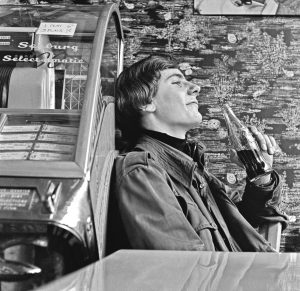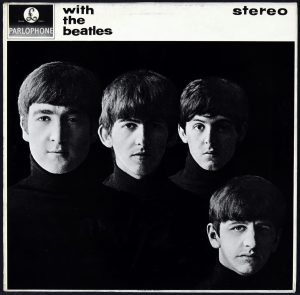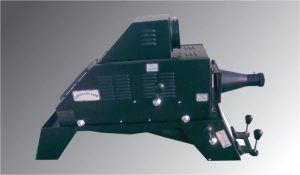The careers master at the Scarborough High School for Boys was not very supportive of my ambition to apply for a photography course at Hull College of Art, rather than staying on at school to do A-levels. I had developed a real interest in photography while working at Croft’s and had decided I would like to take it further. I was far too headstrong and independent to be deflected by the master’s suggestion of an alternative occupation in engineering drawing, so autumn 1963 saw me start in the photographic department at the college Middleton Street annex, lodging with Mr & Mrs Lloyd in a prefab on Preston Road in East Hull.
 My first week at college was a nightmare. It was enough that I had recently had my hair styled with a Beatle ‘moptop’ but much worse, I had no upper front teeth! A perverse old dentist in Scarborough had removed them because they were not straight and I had to wait a week for my false teeth attached to a plate, which would replace them. This week started out pretty technical, which suited me at the time, giving me the confidence that I had made the right decision and to hell with careers masters. What did they know?
My first week at college was a nightmare. It was enough that I had recently had my hair styled with a Beatle ‘moptop’ but much worse, I had no upper front teeth! A perverse old dentist in Scarborough had removed them because they were not straight and I had to wait a week for my false teeth attached to a plate, which would replace them. This week started out pretty technical, which suited me at the time, giving me the confidence that I had made the right decision and to hell with careers masters. What did they know?

At weekends, I returned home to attend the Friday night meetings of the Scarborough Railway Society. These took place in an old railway carriage overlooking the goods yard, now the site of a supermarket. What else? Saturdays would find me at Crofts, supplementing my meagre grant and financing my hobby with work for my employers and a little sideline I had developed, printing postcard size prints of railway pictures taken by fellow society members. These were not for the post. At the meetings we gave what became to be known as slide shows but this was before the time of reliable colour slide film and projectors. To show our pictures we used an epidiascope.

This is an old style of projector. You placed photographic prints on a platen underneath the hulk of the machine and turning a handle on the side raised the photo into its bowels, for the image to magically appear on a screen at the other end of the carriage, all be it very faint. On many occasions these railway pictures would be shown to the assembled railway enthusiasts and train spotters alike, to the live soundtrack of a steam engine shunting the goods yard below.
For me, train spotting had been a road to freedom from a very early age. Parents at that time were happy that their sons had a hobby that fully occupied them, without parental involvement. Can you imagine a parent today allowing their 13 year old son and his mates, whoever they were, to catch a train from Scarborough and travel all the way to Manchester and back. Nowadays, these events seem very alien. Oh, and the archive pictures you see of train spotters in their school blazers on the end of station platforms. This was nothing to do with allegiance to their school, it was probably as in my case, that this was the only jacket they possessed. This was a very different world.
However, while train spotting may have left me with a number of old redundant books with numbers underlined or not and a box of black and white negatives, the one positive that it gave me, which still remains today, is a very good grasp of this country’s geography. OK, the whereabouts of Woodford Halse may not have been that useful, but the knowledge of the location of many of my train spotting destinations has been.
By 1964 I had been interested in trains for over six years and I was now 17 but Sundays would still find me spending my ill-gotten gains aboard a chartered bus along with fellow society members on trips to the West Riding of Yorkshire, The Durham Coalfield or further afield to ‘shed bash’. In the words of my old friend John Varnom, “The shed bash was a punishing ritual, which was a regular feature of the enthusiast’s chosen calling.”
“Grown men and boys took a train from Scarborough to Leeds in time for the reserved coach at midnight to Oxford. There the bash began. Oxford shed at 7.00am. Coach on to Reading. Reading shed at 8.30. Coach on to Basingstoke shed at 9.30 and then Eastleigh works at 11.00, rapidly followed by Eastleigh shed at 12.30pm. Coach to Swindon, its works for 2.00 and then shed, for 3.30. Coach on to Banbury in time for the shed at 6.00, taken at a fast enough pace to reach Woodford Halse and its immense but already declining shed, sited in what seemed the middle of nowhere, at 7.30. Coach back to Leeds in time for a train to York, which connected with the early morning mail train back to Scarborough.”
“Twenty four hours of tramping through oil and ash, the intermittent eating of stale sandwiches washed down by minerals, uncomfortable seats and the invariable smell of vomit from the back of the bus, these were the mechanics of the bash, the objective of which on this particular occasion, the 21st June 1964, was amply fulfilled with 480 cops and 108 pictures.”
While the shed bash, especially on a Sunday, satisfied the insatiable appetite of my ABC for newly underlined cops, it did nothing for photography as a creative medium, a concept which I was beginning to grasp at college. With reduced workings at weekends, mostly what was on offer was rows of cold dirty engines, languishing between piles of ash and the rubble of a decaying transport system. The three quarter ‘record’ shot was just about all that was available unless you had a unique creative eye, which a few enlightened railway photographers had at the time, notably Collin Gifford. Unfortunately, I was still too young and inexperienced to realise that there were great images to be made, if only I could see them.
While steam struggled on for a further four years, notably in the North West, it was becoming more and more difficult to find local working steam. With a regular diet of surplus steam locomotives stored at the back of derelict sheds, or even worse in various states of dismantle in a multitude of scrap yards across the country, I became disenchanted with recording the end of an era and started to look to the future.
By September of that year, my allegiance had changed.
My music business pictures are available at Getty Images and on my own website briancooke.com. Some more of my railway pictures can be found here.
